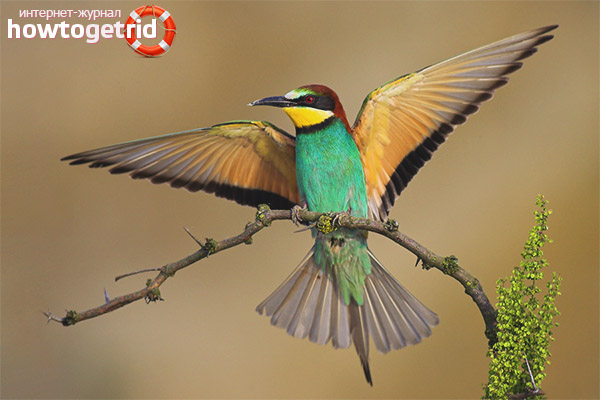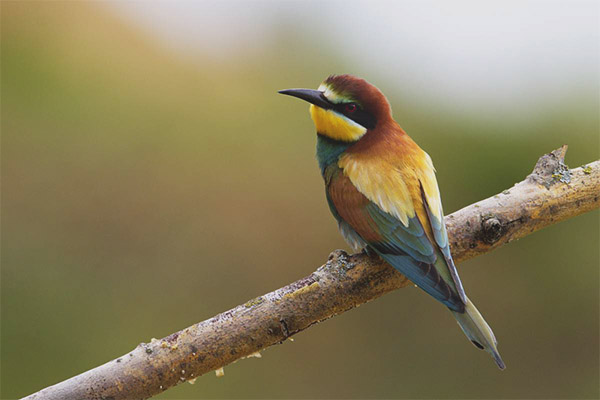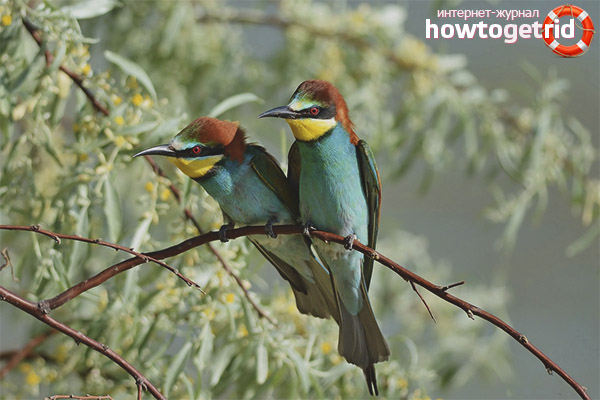The content of the article
The golden bee-eater is not difficult to recognize by the elongated forms of its body, as well as the variegated plumage, decorated with different colors. She is able to deftly catch insects on the fly, but among others the bird gives preference to bees. Beekeepers are concerned about the habits of this bird and seek to protect themselves from its invasions. In total, there are 28 different species of bee-eaters, of which 18 have chosen Africa as their habitat.
Features
In the old days, this bird was called a bee-eater, its belonging belongs to the family of droopers. It has a few more names, two of which are the goldgold and the yellowcone. The individual has a beak 3.5 centimeters long, which is characterized by a curved shape.In the area of the beak, the head is painted white, and closer to the crown there is a bluish-green plumage.
From the beak to the ear, crossing the eye, there is a stripe of bright black color, and the bird's eyes are painted blue. The plumage, located in the region of its throat, has a bright yellow character, a strip of black color separates it from the chest part. Its back received a yellow-ocher color, and the motley wings are composed of green, as well as brown and blue feathers. The tail of this bird has a wedge-shaped form, it is composed of greenish-blue plumage. The middle feathers of her tail have a somewhat elongated shape, and her legs are painted with a reddish-brown tinge.
Favorite habitat
The European bee-eater is referred to as migratory birds, capable of crossing long distances in their migrations. She prefers to spend summer in southern and eastern Europe or in south-western Asia, and in winter she flies to the African continent, south of the desert region of the Sahara.
In addition, it can winter in the southern part of Arabia or in the eastern part of India.It is noteworthy that if the terrain has a short summer period, accompanied by climate humidity, it is not suitable for the habitat of the bee-eater. For its breeding grounds, this bird prefers to choose spaces located in the north of Africa, selected areas of south-western Asia or southern Africa. It was also noticed that in the territory of Italy the population of bee-eaters of about 10,000 pairs breeds annually; here they adhere to a height of 500 meters from sea level.
Features habits and lifestyle
These birds prefer to build their nesting places in burrows that are located in the planes of the steep slopes of ravines or cliffs; various beams or steep banks of some rivers are also suitable for this purpose.In the sheer surface of the selected area, the birds arrange holes about 6 centimeters in diameter, dropping them about a meter from the upper line of the horizontal plane.
Young chicks acquire the ability to fly by mid-summer. These bees return to their nesting sites in spring, from the beginning of April to mid-May. It is noteworthy that, going to a seasonal flight to the wintering grounds, the birds clog the entrance to their “apartment” with clay, thus preventing the colonization of other birds.
On serene days, when there is no wind and the sun is not covered by clouds, golden bee-eaters prefer to hunt at high altitude, eating insects that have risen into the air. When atmospheric pressure does not allow insects to fly high, the birds have to go lower. But this is not a problem for them, because they are able to arrange their hunt almost at the surface of the soil, especially on cloudy days with rainy weather.
Flight features

Golden bee-eater is distinguished by dexterity and speed of flight, it carries out several energetic flapping of wings and hovers at high speeds.Her flight can be compared with the flight of a swallow or a starling, although sometimes she can use distinctive techniques. At times, she has to freeze in her flight, after which, using vigorous beats of her wings, the bird performs trembling actions, resembling the style of a kestrel or a falcon. When the weather pleases on clear days, these birds are able to climb into the sky to a great height, from which they can no longer be distinguished.
Individual voice characteristics
A distinctive feature of the golden bee-eater are the bright colors of its colorful plumage. But no less individual has an unusual bird voice. During takeoff, they make a piercing sound, consonant with the sound combination “pr-u-hipp”. And for normal communication, birds choose quieter and intermittent trills, although they are audible from a great distance because of the height of the key. Silence bee-eaters do not differ, their flight is able to be accompanied by continuous communication. In the period of wandering, these birds like to choose single large trees, settling on their spreading branches, and designate their presence with muffled sounds of their voices.
Diet
An exceptional component of the diet of birds of this species are all kinds of insects. In addition, for the most part, their diet is represented by different types of flying insects. Although sometimes the prey of the bee-eaters can become creeping representatives of the “insect kingdom”, who were not lucky enough to be at the tops of the plants.
Per day, the adult bee-eater is capable of absorbing up to 40 grams of various insects. In quantitative equivalent this mass can be represented by 225 bees. The most desired trophy for this bird is the representatives of the order of Hymenoptera, which are bees and wasps. This is followed by the bulk of the flying insects, diptera and orthoptera, which are represented by mosquitoes, larvae of numerous dragonflies, beetles, consisting of ground beetles and leaf beetles, as well as all sorts of butterflies. Among other things, these birds will not miss the opportunity to eat bumblebees and hornets, as well as midges.
Knowing that favorite prey is capable of stinging bites, the bee-eater adapted to crush bees and wasps before swallowing them.After killing the victim, the bird slowly removes its insides.
Nesting period
Upon returning to the nesting sites in spring, the golden bee-eaters endure a certain pause, which is necessary for adaptation. After that, the birds accumulate in places that have sheer surfaces, and arrange their nests close to each other. In very rare cases, birds are able to build their nests on flat surfaces.
In order for the hole to get the desired shape and size, the birds have to spend a lot of time. They dig a burrow ditch jointly, the female and the male alternately throw out the soil, moving backwards. They prefer to engage in construction work in the morning and evening hours. Much depends on the hardness of the soil, but on average, birds make their holes in 10-20 days. The weight of the soil that the birds need to move is about 12 kilograms.
The length of the bee-eater burrow can reach 2 meters, it ends with a notch forming a chamber, which the female uses for her laying consisting of 6-7 eggs with a white shell. The incubation period of these birds is 20 days; both parents take part in this process.25 days after the birth, the young individuals acquire the ability to fly.
Damage to beekeeping
If the golden bee-eaters settled near the location of the apiary, then bees will become their main prey. One bee colony consists of approximately 30 thousand individuals, the adult bee-eater is able to destroy up to 2% of the number of this family per day. During the summer period, the pair of bee-eaters exterminates about 2,000 insects. And if in the neighborhood with an apiary consisting of 50 families, a flock of bee-eaters settled down, then the income of this apiary will be reduced to 0.
There were cases when about 180 working bees numbered in the craw of this bird, and its tongue was covered with insect stings. It is noteworthy that bee venom does not have any effect on the golden bee-eater. The greatest danger to beekeepers of this species is from July to mid-September.
The benefits of extermination of the bee-eater insects bring very small, these characteristics are the main reason for the reduction of the population of these birds in many European regions. Indeed, in addition to the harm caused to beekeeping, the bee-eaters are able to seriously reduce the populations of bumblebees necessary for pollination of clover.
Beekeepers and farmers are very unhappy with similar neighborhoods and sometimes use the most drastic measures to eradicate feathered pests. At night, when the bird family hides in a hole, they put a rag soaked in chloropicrin. After that, the hole is blocked, and all the inhabitants perish. In addition, beekeepers conduct active shooting of this species of birds.
Video: European bee-eater (bee-eater)












To send